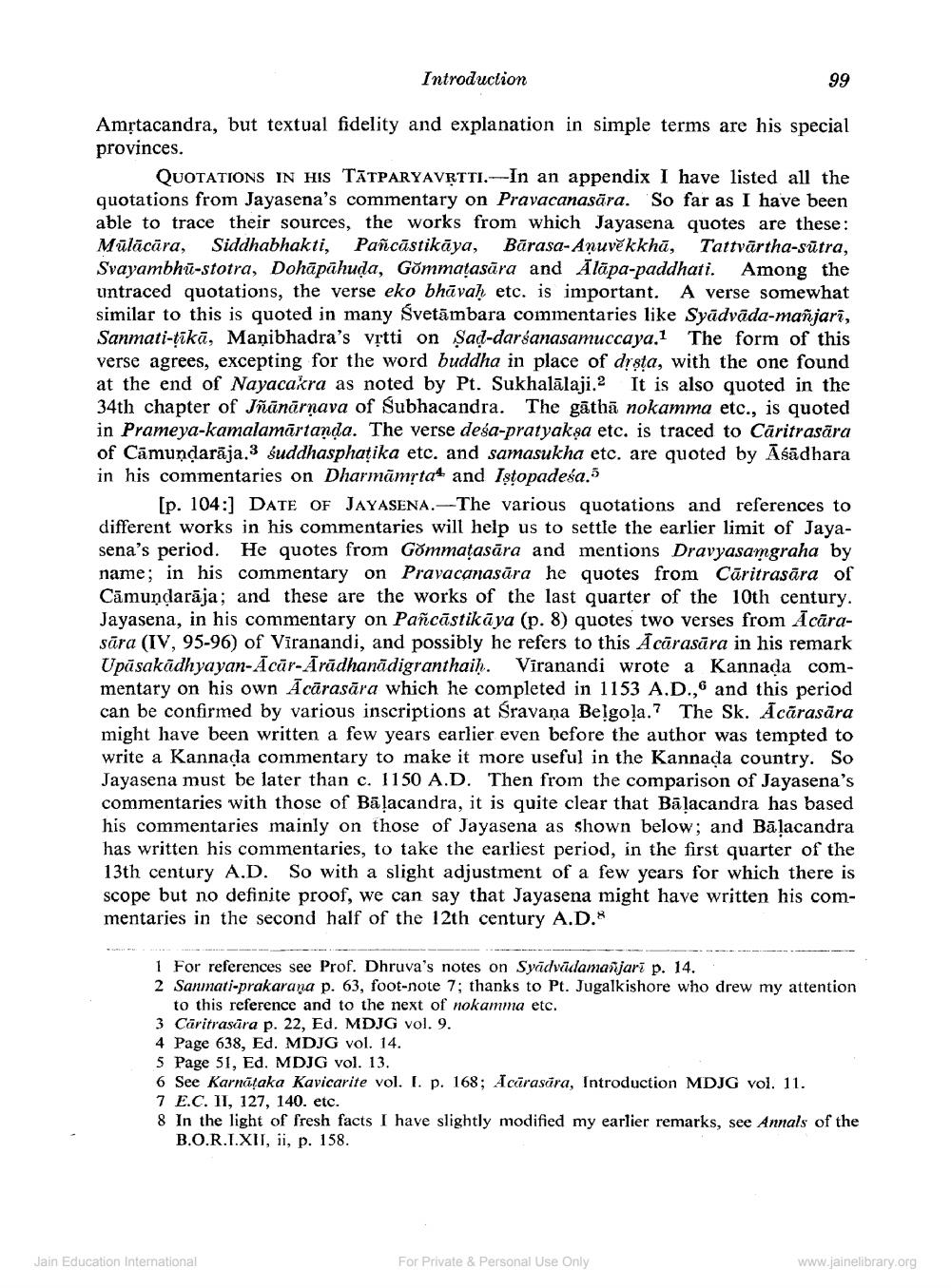________________
Introduction
99
Amộtacandra, but textual fidelity and explanation in simple terms are his special provinces.
QUOTATIONS IN HIS TĀTPARYAVRTTI.-In an appendix I have listed all the quotations from Jayasena's commentary on Pravacanasāra. So far as I have been able to trace their sources, the works from which Jayasena quotes are these: Mūlācāra, Siddhabhakti, Pañcāstikāya, Bārasa-Anuvěkkhā, Tattvārtha-sūtra, Svayambhū-stotra, Dohāpāhuda, Gõmmatasāra and Aläpa-paddhati. Among the untraced quotations, the verse eko bhāvah etc. is important. A verse somewhat similar to this is quoted in many Svetāmbara commentaries like Syādvāda-mañjarī, Sanmati-tīkā, Manibhadra's vịtti on Şad-darśanasamuccaya,1 The form of this verse agrees, excepting for the word buddha in place of drsta, with the one found at the end of Nayacakra as noted by Pt. Sukhalālaji.2 It is also quoted in the 34th chapter of Jñānārņava of Subhacandra. The gāthā nokamma etc., is quoted in Prameya-kamalamārtanda. The verse desa-pratyaksa etc. is traced to Cāritrasāra of Cāmundarāja 3 śuddhasphatika etc. and samasukha etc. are quoted by Āsādhara in his commentaries on Dharmāmsta4 and Istopadeśa.
[p. 104:) DATE OF JAYASENA.--The various quotations and references to different works in his commentaries will help us to settle the earlier limit of Jayasena's period. He quotes from Gommațasāra and mentions Dravyasamgraha by name; in his commentary on Pravacanasāra he quotes from Cāritrasāra of Cāmundarāja; and these are the works of the last quarter of the 10th century. Jayasena, in his commentary on Pañcāstikāya (p. 8) quotes two verses from Ācārasāra (IV, 95-96) of Viranandi, and possibly he refers to this Ācārasāra in his remark Upāsakādhyayan-Acūr-Arādhanādigranthaih. Viranandi wrote a Kannada commentary on his own Ācārasāra which he completed in 1153 A.D., and this period can be confirmed by various inscriptions at Sravana Belgola.? The Sk. Ācārasāra might have been written a few years earlier even before the author was tempted to write a Kannada commentary to make it more useful in the Kannada country. So Jayasena must be later than c. 1150 A.D. Then from the comparison of Jayasena's commentaries with those of Bā ļacandra, it is quite clear that Bālacandra has based his commentaries mainly on those of Jayasena as shown below; and Bālacandra has written his commentaries, to take the earliest period, in the first quarter of the 13th century A.D. So with a slight adjustment of a few years for which there is scope but no definite proof, we can say that Jayasena might have written his commentaries in the second half of the 12th century A.D.
1 For references see Prof. Dhruva's notes on Syādvaidamasjari p. 14. 2 Sanmati-prakarana p. 63, foot-note 7; thanks to Pt. Jugalkishore who drew my attention
to this reference and to the next of nokamma etc. 3 Caritrasāra p. 22, Ed. MDJG vol. 9. 4 Page 638, Ed. MDJG vol. 14. 5 Page 51, Ed. MDJG vol. 13. 6 See Karnāļaka Kavicarite vol. I. p. 168; Acārasăra, Introduction MDJG vol. 11. 7 E.C. II, 127, 140. etc. 8 In the light of fresh facts I have slightly modified my earlier remarks, see Annals of the
B.O.R.I.XII, ii, p. 158.
Jain Education International
For Private & Personal Use Only
www.jainelibrary.org




